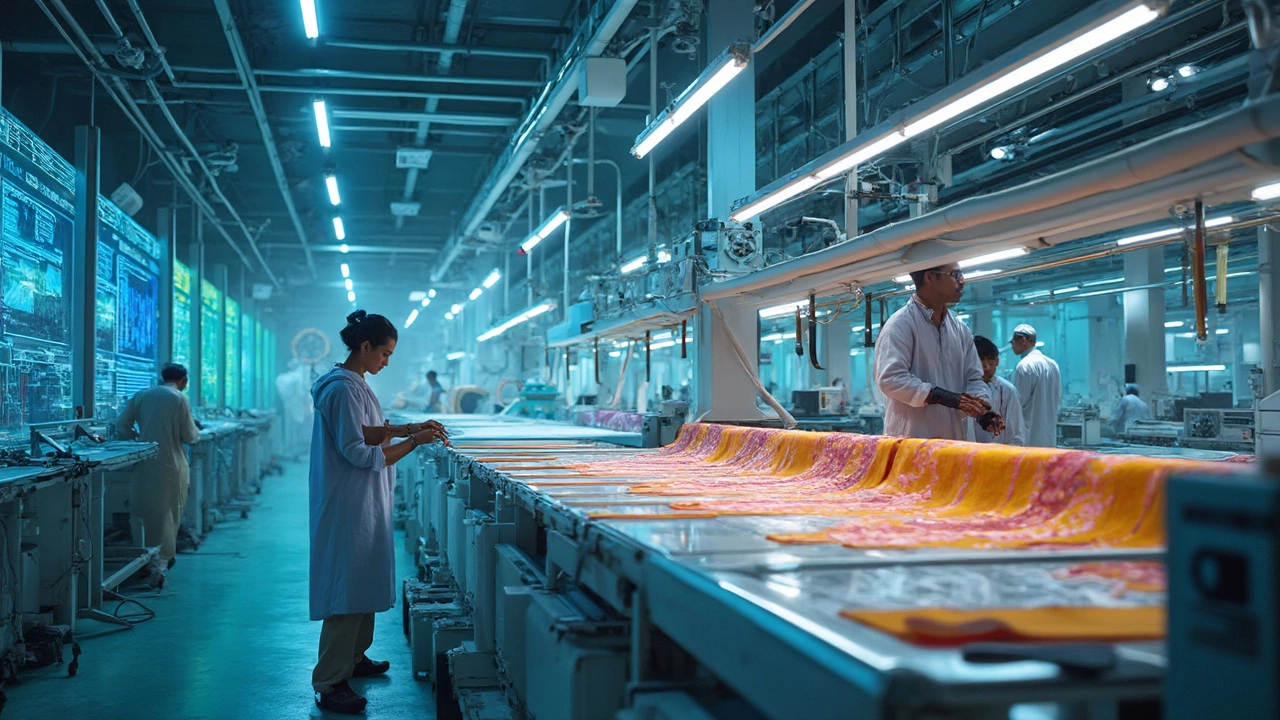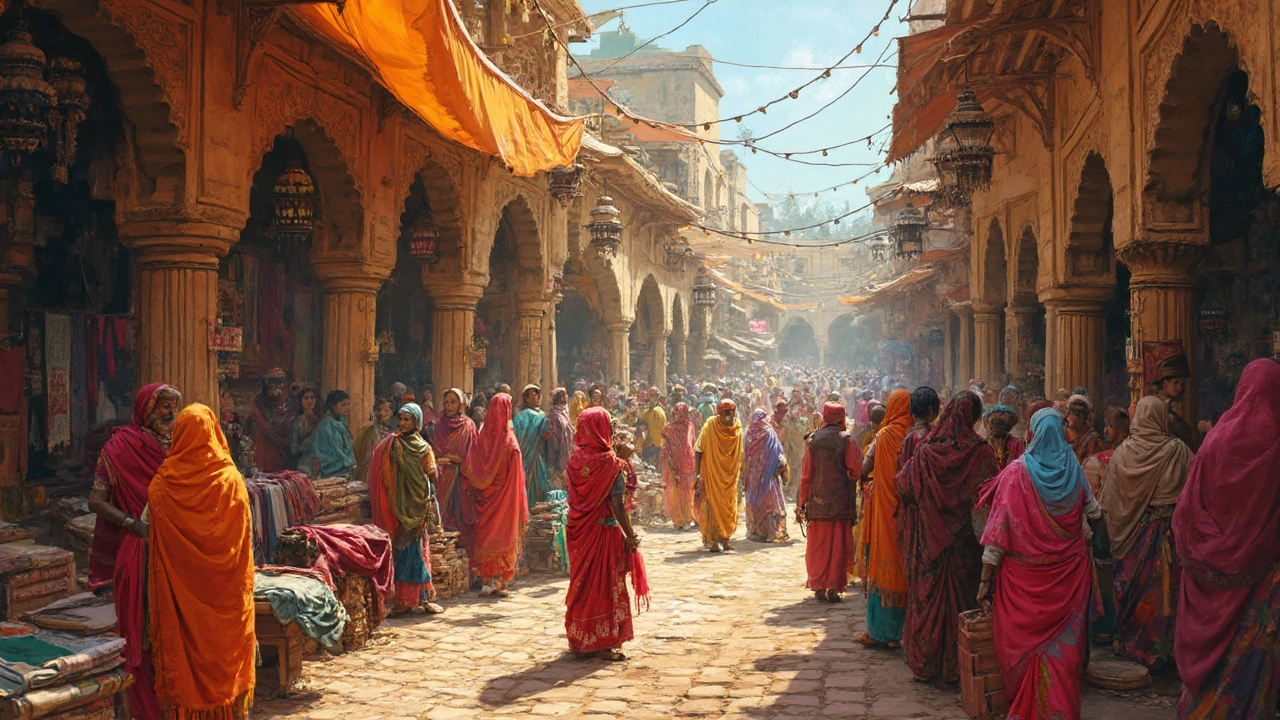The Indian textile industry is nothing short of fascinating. This isn't just about colorful saris and rich traditional garments; it's a colossal part of the global textile market. Ever thought about who dominates this giant industry? Let's start unraveling this.
India's textile roots dig deep, with centuries-old techniques still cherished today. But, it's not just the past that keeps the engine running. Huge companies have emerged, blending heritage with innovation. Wondering who they are? Well, we'll get there soon.
You might have guessed it right—the biggest players currently churn out everything from high-fashion fabrics to industrial textiles. Their secret sauce? It's a mix of technology, vast infrastructure, and a knack for anticipating market trends.
- A Glimpse Into India's Textile Heritage
- Top Textile Giants Making Waves
- Innovations Driving the Industry Forward
- The Future of Textile Manufacturing in India
A Glimpse Into India's Textile Heritage
India's textile history is incredibly rich and diverse, dating back centuries. It's no wonder the country boasts one of the world's largest textile industries today. From ancient times, textiles have been a significant part of Indian culture and economy, shaping everything from local crafts to major trade routes.
Consider the Indian textile industry as it was during the times of the Indus Valley Civilization. Even back then, around 2500 BCE, India was known for its advanced weaving techniques. Textiles like cotton and wool were commonly used, with evidence of dyed fabrics that have been found in ruins for archaeologists to drool over.
Moving forward to the Mughal era, Indian textiles gained a new level of fame. The Mughals, particularly known for their luxurious tastes, invested heavily in the textile trade. They loved opulent materials like silk and brocade, boosting exports that remain legendary, such as muslin from Bengal.
Cultural Significance
Textiles in India aren't just about business; they are woven into the very fabric of everyday life. Festivals, weddings, and religious ceremonies often feature extravagant attire, showcasing the nation's love for vibrant textiles. Yet, it's not only about color. Each region in India has its own traditional techniques and patterns, from the block prints of Rajasthan to the intricate weaves of Tamil Nadu.
India's Role in Global Trade
Historically, India has been a hub for textile manufacturers. The British saw this potential during the colonial era, leading to the global spread of Indian textile patterns. Today, Indian textiles remain a significant player on the world stage, not just for their beauty but also for their sustainability. Many companies now focus on eco-friendly practices, echoing traditional Indian respect for nature.
This rich heritage is more than just a backdrop for the industry's current achievements. It's a living, breathing part of why and how textile manufacturers in India continue to excel.
Top Textile Giants Making Waves
When it comes to the largest textile industry players in India, a few names consistently pop up due to their massive footprint and innovation in the market.
Reliance Industries Limited
This isn't just a big name in oil and gas—Reliance has its fingers in the textile pie too, specifically via its subsidiary Reliance Textile Industries. They're well-known for their polyester production, and it's a crucial part of how India maintains its edge in synthetic fibers globally.
Arvind Limited
Arvind Limited is a heavyweight in the Indian textile industry, especially in the denim segment. They supply to some of the world’s biggest apparel brands. Their strength lies in massive production capabilities and a sharp focus on sustainability—always a plus these days.
Vardhman Textiles
No conversation about top textile companies is complete without mentioning Vardhman. Known for its yarn production, Vardhman is often associated with quality and reliability. Their ability to stay competitive comes from their diverse product range and adaptability to market changes.
Raymond Group
Famous for their high-end fabrics, the Raymond Group has been a household name in the textile sector. They specialize in luxury garments and fabrics, setting trends while catering to premium markets.
Here's a quick look at their production scope:
| Company | Specialty | Global Presence |
|---|---|---|
| Reliance Industries | Polyester Production | Strong |
| Arvind Limited | Denim | Wide |
| Vardhman Textiles | Yarn | Expanding |
| Raymond Group | Luxury Fabrics | Established |
These companies not only dominate in terms of size and production but also lead in using new technologies and sustainable practices. They're paving the way for the future of Indian textiles, one innovative thread at a time.

Innovations Driving the Industry Forward
Have you ever wondered what keeps the Indian textile industry ticking and ahead of the curve? It's not just about spinning yarns anymore. Innovations are the backbone of modern success stories, especially for the largest players in the market.
Green Manufacturing Practices
One of the standout trends is sustainability. Companies are pushing for environmentally friendly production methods. For instance, many are investing in recyclable fabrics and reducing water usage in manufacturing. This not only makes good business sense, but it also resonates with the increasingly eco-conscious consumer base.
Technology to the Rescue
Advancements in technology, like AI and IoT, are revolutionizing how textiles are produced. Factories are getting smarter with automated processes, which means faster production times and fewer errors. A Bloomberg report highlights this shift:
“Automation and digitalization are not just an edge but a necessity for textile manufacturers to remain competitive.”
Efficient Supply Chains
Another shift is in supply chain efficiency. By optimizing logistics and inventory management with new tech tools, companies are slashing delivery times and cutting costs.
Some companies are even exploring blockchain for transparency, ensuring every step, from cotton farm to closet, is accounted for.
Innovative Materials
Exploring new materials is also a hot topic. Fancy a shirt made from banana fibers? Companies are getting creative with raw materials to offer unique fabrics that are both durable and appealing. These innovations are not just gimmicks; they're shaping the future of fabrics.
The ability of India's textile giants to adapt and thrive with these innovations is what maintains their position at the top. With such rapid advancements, we're surely on the brink of a textile renaissance.
The Future of Textile Manufacturing in India
You ever wondered what’s next for India's textile industry? It’s got a bright road ahead, and that’s no surprise considering how these companies have been blending tradition with the latest tech. Here's how the future is shaping up.
Technology and Sustainability
Technology is making waves everywhere, and textiles aren't an exception. We're seeing big moves towards automation and smart textiles. Companies are investing in machines that can weave fabrics more efficiently and with less waste.
Sustainability is the buzzword these days. Indian manufacturers are stepping up eco-friendly practices, from using organic materials to reducing water consumption in the dyeing process. It’s about making the planet happy, while keeping that business edge.
The Global Market Reach
India is already a massive exporter of textiles, but there’s potential for more. With trade policies easing up and quality getting better, the goal is to tap into new markets. The largest textile manufacturers are eyeing the booming fast fashion market without losing traditional customers.
Focus on Innovation
The leaders in this industry aren't resting on their laurels. There’s this constant push for innovation, which means looking into new fabric technologies like antimicrobial and water-repellent textiles. This innovation keeps them a cut above the rest.
| Year | Export Value (US$ Billion) |
|---|---|
| 2022 | 40 |
| 2023 | 45 |
| 2024 (Estimate) | 50 |
These numbers show the trend towards increasing exports, reflecting the growth driven by these innovative practices.
It’s clear the future is promising for Indian textile manufacturers. By embracing tech and sustainability while pushing for greater market reach, they're all set to lead the global textile stage.
